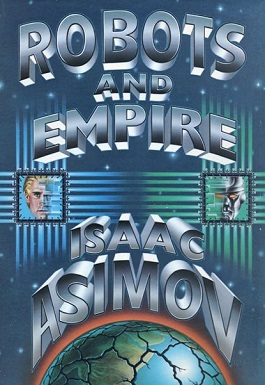Related Research Articles

Robots and Empire is a science fiction novel by the American author Isaac Asimov, published by Doubleday Books in 1985. It is part of Asimov's Robot series, which consists of many short stories and five novels.
Empire series may refer to:
An empire is a group of states or peoples under centralized rule.

Faerie Tale is a supernatural thriller, falling within the subgenre of contemporary fantasy, by American writer Raymond E. Feist, first published in 1988.

Magician is a fantasy novel by American writer Raymond E. Feist. It is the first book of the Riftwar Saga and of the wider Riftwar Cycle. Magician was originally published in 1982. The book is set in a Dungeons & Dragons–style fantasy world called Midkemia, originally invented by Feist and his friends during college. The story follows the early life of friends Pug and Tomas as their world is overtaken by war against alien invaders who appear via portals.
Janet Inglis "Janny" Wurts is an American fantasy novelist and illustrator. She has written several standalone novels and series, including the Wars of Light and Shadow, The Cycle of Fire trilogy and the internationally best-selling Empire trilogy that she co-authored with Raymond E. Feist. Her short story collection That Way Lies Camelot was nominated for the British Fantasy Award in 1995. She often illustrates her own books, and has won Chesley Awards for her artwork.

The Riftwar Saga is a series of fantasy novels by American writer Raymond E. Feist, the first series in The Riftwar Cycle.

Silverthorn is a fantasy novel by American writer Raymond E. Feist, the sequel to Magician. Released in 1985, it was followed by A Darkness at Sethanon, the final book in The Riftwar Saga.

The Empire Trilogy is a collaborative trilogy of political fantasy novels by American writers Raymond E. Feist and Janny Wurts, set in the fictional world of Kelewan. It is the second trilogy in Feist's The Riftwar Cycle.
Geoff Taylor is an English fantasy artist.

Into a Dark Realm is a fantasy novel by American writer Raymond E. Feist. It is the second book in the Darkwar Saga and was published in 2006. It was preceded by Flight of the Nighthawks and followed by the final book in the saga, Wrath of a Mad God.
The Wars of Light and Shadow is a series of fantasy novels by American author Janny Wurts. It consists of eleven volumes grouped into five story arcs, in the pattern 1 - 2 - 5 - 2 - 1.

The Darkwar Saga is a series of fantasy novels by the American writer Raymond E. Feist.

Flight of the Nighthawks is a fantasy novel by American writer Raymond E. Feist. It is the first book in the Darkwar Saga and was published in 2005. It was followed by Into a Dark Realm which was published in 2006.
Mistress of the Empire is a fantasy novel by American writers Raymond E. Feist and Janny Wurts. It is the third and final book in the Empire Trilogy and was published in 1992. It was preceded by Servant of the Empire, which was published in 1990.
Servant of the Empire is a fantasy novel by American writers Raymond E. Feist and Janny Wurts. Published in 1990, it is the second book in the Empire Trilogy, preceded by 1987's Daughter of the Empire and followed by Mistress of the Empire in 1992.
The Riftwar Cycle is the name given to the series of books authored or co-authored by Raymond E. Feist that revolve around the fantasy worlds of Midkemia and Kelewan.

Mara can be either a surname or a first name. Mara is Irish for ocean.
This is a complete bibliography of the works by American fantasy fiction author Raymond E. Feist.
References
- ↑ "Review: Daughter of the Empire by Raymond E. Feist & Janny Wurts". Publishers Weekly . June 1987. Retrieved June 4, 2023.
- ↑ Davies, Barbara (October–November 1987). "[Review of]Daughter of the Empire – Raymond E. Feist & Janny Wurts" (PDF). Vector . p. 19 – via Fanac.
- ↑ Sheddan, Marilyn K. (30 August 1987). "A DAUGHTER OF THE EMPIRE STRIKES BACK". Orlando Sentinel . Retrieved 22 September 2024.
- ↑ Searles, Baird (February 1988). "Noh Fantasy" . Asimov's Science Fiction . Vol. 12, no. 2. pp. 188–189.